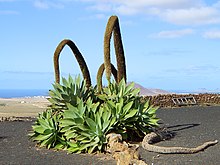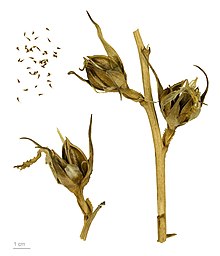bio.wikisort.org - Plant
Agave attenuata is a species of flowering plant in the family Asparagaceae, commonly known as the foxtail or lion's tail. The name swan's neck agave refers to its development of a curved inflorescence, unusual among agaves.[3] Native to the plateaux of central west Mexico, as one of the unarmed agaves, it is popular as an ornamental plant in gardens in many other places with subtropical and warm climates.[4]
| Agave attenuata | |
|---|---|
 | |
Conservation status | |
| Scientific classification | |
| Kingdom: | Plantae |
| Clade: | Tracheophytes |
| Clade: | Angiosperms |
| Clade: | Monocots |
| Order: | Asparagales |
| Family: | Asparagaceae |
| Subfamily: | Agavoideae |
| Genus: | Agave |
| Species: | A. attenuata |
| Binomial name | |
| Agave attenuata Salm-Dyck 1834 | |
| Synonyms[2] | |
| |
Description

Although the plant can appear acaulescent, stems often reach 50 to 150 cm (20–60 in) in length, and old leaves fall off, leaving the stems visible. The leaves are ovate-acuminate, 50–70 cm (20–28 in) long and 12–16 cm (5–6 in) wide, pale in color, ranging from a light gray to a light yellowish green. There are no teeth, nor terminal spines, although the leaves taper to soft points that fray with age. The numerous, broad, succulent, tapering leaves are slightly less rigid than most Agave species' leave;, they are a bright glaucous gray to light yellowish-green and stingless.[5]
The inflorescence is a dense raceme 2.5 to 3 meters (8 to 10 ft) high (usually curved), with greenish-yellow flowers, growing after many years.[6] As with other Agave species, the plant dies following seed development, but numerous suckers consequently sprout, both from the base of the plant and from the flower raceme.
It has two subspecies:
- A. attenuata subsp. attenuata: Native to Central and Southwest Mexico and naturalized in Madeira and Libya.[7]
- A. attenuata subsp. dentata (J.Verschaff.) B.Ullrich: Native to Northwest and Southwest Mexico.[8]
Etymology
The Latin specific epithet attenuata means "with a narrow point".[9]
Range
Specimens were sent to Kew Gardens by the explorer Galeotti in 1834, from an unspecified location in central Mexico. A more recent study has reported it from Jalisco, east to Mexico State, in small colonies at elevations of 1,900 to 2,500 meters (6,200 to 8,200 ft), but there have been few sightings, suggesting this agave is rare in the wild.[6] IUCN reports the species from the states of Colima, Durango, Guerrero, Jalisco, Michoacán, Nayarit and Mexico State, at altitudes between 400 and 2,500 meters (1,300 and 8,200 ft) on volcanic rock cliffs within pine forests and transitional zones of tropical dry and temperate forests types in mountains.[1] It is reportedly naturalized in Libya[10][11] and Madeira[11] and is widely spread through the Mediterranean and the rest of Macaronesia.
Cultivation

In cultivation, Agave attenuata is said to prefer relatively moist loamy soil, although it can cope with poor soil and dry conditions. It should be protected from direct sunlight in summer and from long periods of frost.[12] It is hardy down to USDA Zone 9b.[13][14]
Gallery
- A specimen leaning as the floral stem grows
- Flower raceme
- Flower closeup
- Fruits developing following bloom
- A cluster of A. attenuata starting to form their flower spikes (overhead view)
References
- García-Mendoza, A.J.; Sandoval-Gutiérrez, D.; Torres-García, I.; Linares, J. (2019). "Agave attenuata". IUCN Red List of Threatened Species. 2019: e.T114936958A114963376. doi:10.2305/IUCN.UK.2019-3.RLTS.T114936958A114963376.en. Retrieved 20 November 2021.
- The Plant List, Agave attenuata
- Robert Zander : Zander hand dictionary of plant names. Edited by Fritz Encke , Günther Buchheim, Siegmund Seybold .15th edition, corrected reprint of the 14th edition. Eugen Ulmer, Stuttgart 1994, ISBN 3-8001-5072-7
- "Agave attenuata".
- Joachim Thiede: Agave chamelensis . In: Urs Eggli (ed.): Succulent lexicon. Monocotyledons (monocotyledons) . Eugen Ulmer, Stuttgart 2001, ISBN 3-8001-3662-7 , P. 14-15 .
- Howard Scott Gentry, Agaves of Continental North America (University of Arizona Press, 1982) pp. 66-71
- "Agave attenuata subsp. attenuata". Catalogue of Life. Retrieved 18 January 2021.
- "Agave attenuata subsp. dentata (J.Verschaff.) B.Ullrich". Catalogue of Life. Retrieved 18 January 2021.
- Harrison, Lorraine (2012). RHS Latin for Gardeners. United Kingdom: Mitchell Beazley. ISBN 184533731X.
- Gordon Cheers (ed.): Botanica . Random House Australia 2003. German edition: Tandem Verlag GmbH 2003, ISBN 3-8331-1600-5
- "Agave attenuata Salm-Dyck". Catalogue of Life. Retrieved 18 January 2021.
- Agave attenuata, The Lovely Plants
- "Agave Species, Durango Soft Agave, Century Plant, Maguey". davesgarden.com. Retrieved 18 January 2021.
- "Agave attenuata (Fox Tail Agave)". worldofsucculents.com. 29 April 2020. Retrieved 18 January 2021.
External links
| Wikimedia Commons has media related to Agave attenuata. |
На других языках
- [en] Agave attenuata
[es] Agave attenuata
Agave attenuata, comúnmente llamada ágave atenuado, ágave del dragón o cuello de cisne, es una especie suculenta perteneciente a la familia de las agaváceas. Un espécimen silvestre de esta especie fue enviado a los Jardines Botánicos de Kew (Inglaterra) por el explorador Galeotti en 1834, desde un lugar sin especificar del centro de México. Estudios recientes lo han localizado en Jalisco, al este del Estado de México, en pequeñas colinas con alturas de 1,900 a 2,500 msnm. No obstante, se han hallado muy pocos ejemplares, por lo que se considera que es un ágave muy raro en estado silvestre.[ru] Агава оттянутая
Ага́ва оття́нутая (лат. Agáve attenuáta) — растение-суккулент; вид рода Агава (Agave) семейства Агавовые (Agavaceae).Другой контент может иметь иную лицензию. Перед использованием материалов сайта WikiSort.org внимательно изучите правила лицензирования конкретных элементов наполнения сайта.
WikiSort.org - проект по пересортировке и дополнению контента Википедии





